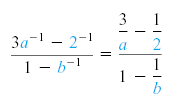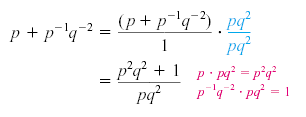Simplifying Expressions with Negative Exponents
Consider the expression

Using the definition of negative exponents, we can rewrite this expression as a
complex fraction:

The LCD for the complex fraction is 2ab. Note that 2ab could also be obtained
from the bases of the expressions with the negative exponents. To simplify the
complex fraction, we could use Method B as we have been doing. However, it is
not necessary to rewrite the original expression as a complex fraction. The next
example shows how to use Method B with the original expression.
Example 1
A complex fraction with negative exponents
Simplify the complex fraction

Solution
Multiply the numerator and denominator by 2ab, the LCD of the fractions.
Remember that a-1 · a = a0 = 1.
Example 2
A complex fraction with negative exponents
Simplify the complex fraction

Solution
If we rewrote a-1, b-2, b-2, and a-3, then the denominators would be a, b2, b2, and a3. So the LCD is a3b2. If we multiply the numerator and denominator by a3b2, the negative exponents will be eliminated:
Note that the positive exponents of a3b2 are just large enough to eliminate all of the
negative exponents when we multiply.
The next example is not exactly a complex fraction, but we can use the same
technique as in the previous example.
Example 3
More negative exponents
Eliminate negative exponents and simplify p + p-1q-2.
Solution
If we multiply the numerator and denominator by pq2, we will eliminate the
negative exponents:

|